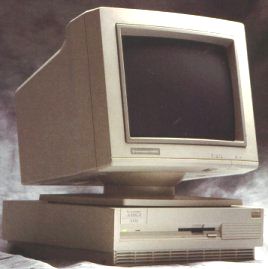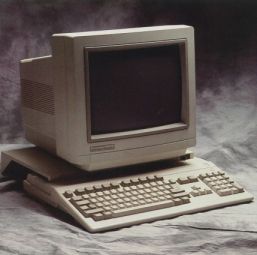Emulation
Amiga Continued:


Amiga 3000 Launch date: April 24th, 1990
The A3000 is a powerhouse in comparison to previous Amiga, it was sold as a high-end graphics workstation. For a time it was used by W Industries as the basis of their highly acclaimed Virtuality machines. At the heart of the A3000 was the powerful 68030 (described in ST/Amiga Format as a 'mainframe on a chip'). In addition the A3000 was the first Amiga to feature the new Kickstart 2 upgrade and Zorro III slots.
To emphasis the A3000s capabilities as a high-end workstation, two operating
systems were included:
The first was the newly released Kickstart/Workbench 2. This was unusual by
the fact that Kickstart was stored on the hard disk rather than in ROM. This
was similar to the A1000 that required Kickstart to be loaded from floppy
disk before anything else could be done.
The second OS to be included with the A3000 was the Unix System (SVR4) V operating system. This allowed the use of the Unix graphical interface, X Windows and Open Look. It also came with standard networking capabilities (probably a first for Commodore), such as TCP/IP, NFS and RFS for networking between different operating systems. In a bizarre twist, the Unix OS was sold on a magnetic tape rather than floppy disk.
Amiga 3000T Launch date: October 1991 Launch price: $4998
In October 1991, Commodore introduced the A3000T, a tower version of their popular A3000 machine. The A3000T uses a 25Mhz 68030 processor, with a 68882 maths-coprocessor, as well as 2MB of 32-bit ram as standard, expandable up to 18MB actually on the motherboard. As it was released before SIMMs became a standard it uses Zip ram, a slower alternative.
If you want an SIMM adapter, you will need to buy a device from mail order. The workstation was aimed at the professional multimedia market, as reflected in the price of the machine- $4498 for an A3000T with a 100MB SCSI hard drive, or $4998 for the 200MB version. It also came with key switch on the case. These are used in the commercial market to disable a machine when it is not being used, locking the mouse and keyboard.
Amiga 500+ Launch date: 1991
This is widely known as the shortest-lived Amiga ever, lasting only 6 months
until it was phased out by the A600. This was yet another of Commodores secrets
with many people opening their Amigas at Christmas expecting to find a A500
only to find something much better. It looked physically similar to the A500,
but updated it with 1mb of ram, Enhanced Chip Set (ECS) and Workbench 2.0
which turned the horrible blue interface of workbench 1.3 into a much more
lovely grey and blue.
It also allowed the user to see files that did not have icons without resorting to the CLI and put among other things the FastFileSystem into ROM (Kickstart) allowing you to boot from FFS disks containing 880k of data.
Amiga 600 Launch date: March 1992
Released in spring 1992 as a replacement to the A500+, the A600 weighed just 6lbs (the smallest Classic Amiga ever!). This 14 deep x 9.5" wide x 3" high system was aimed at the console market, adding very little to the operating system or the Amiga as a whole. It only had 1mb of chip memory, ECS and Workbench 2.05. It shrunk the basic system by doing away with the numeric keypad leaving just 78 keys, and became the nearest the Amiga has to a laptop.
It did, however introduce the PCMCIA slot at the side of machine allowing the use of ram cards; CD drives and disks that fitted into this port. The fatter Agnus chip as standard also allowed the addressing of up to 2Mb Chip ram as standard, with the maximum ram expansion (with PCMCIA) being 6Mb.